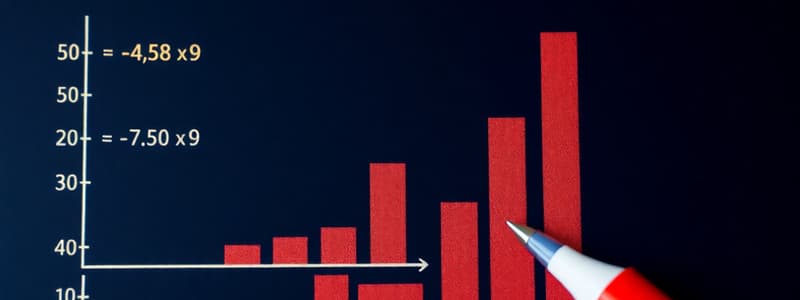Podcast
Questions and Answers
What is the formula for calculating the arithmetic mean of ungrouped data?
What is the formula for calculating the arithmetic mean of ungrouped data?
X = ΣX / N
How is the median calculated in ungrouped data?
How is the median calculated in ungrouped data?
Median = Size (n + 1) / 2 th item
What is the formula to calculate simple interest?
What is the formula to calculate simple interest?
SI = PNR / 100
What is the nth term formula for an arithmetic progression (AP)?
What is the nth term formula for an arithmetic progression (AP)?
Describe how to find the mode of a data set using its formula.
Describe how to find the mode of a data set using its formula.
Flashcards
Arithmetic Mean (Ungrouped)
Arithmetic Mean (Ungrouped)
Sum of all values divided by the total number of values.
Median (Ungrouped)
Median (Ungrouped)
Middle value in ordered data.
Simple Interest Formula
Simple Interest Formula
Interest calculated based on the principal amount only.
Arithmetic Progression (nth term)
Arithmetic Progression (nth term)
Signup and view all the flashcards
Compound Interest Formula
Compound Interest Formula
Signup and view all the flashcards
Study Notes
Module 5: Measures of Central Tendency and Dispersion
- Arithmetic Mean (Ungrouped Data): X̄ = ΣX / N
- Arithmetic Mean (Grouped Data): X̄ = Σfx / Σf
- Median (Ungrouped Data): The middle value in arranged data. (n + 1) / 2
- Median (Grouped Data): Median = L₁+ (n/2 - CF) * i / f
- L₁ = Lower limit of the median class
- n = total frequency
- CF = Cumulative frequency of the class preceding the median class
- i = class interval
- f = frequency of the median class
- Mode: The most frequently occurring value.
- Mode = L+ [(Δ₁ / (Δ₁ + Δ₂)] * i
- L = lower limit of modal class
- Δ₁ = difference between the frequency of modal class and the frequency of the class preceding it
- Δ₂ = difference between the frequency of modal class and the frequency of the class succeeding it
- i = class interval
Module 5: Measures of Dispersion
-
Range: H - L (where H= highest value and L=lowest value)
-
Coefficient of Range: (H-L) / (H+L)
-
Standard Deviation (Ungrouped Data): √Σ(X - X̄)² / N
-
Standard Deviation (Grouped Data): √Σf(X - X̄)² / Σf
-
Mean Deviation (Ungrouped Data): Σ|X - X̄| / N
-
Mean Deviation (Grouped Data): Σf|X - X̄| / Σf
-
Quartile Deviation: (Q₃ - Q₁ ) / 2
- Q₁ = First quartile, Q₃ = Third quartile
-
Quartiles (Continuous Data): Q1 = L₁ + [(n/4) - CF] * i / f Q3 = L₁ + [(3n/4) - CF] * i / f
- L₁ - Lower limit of the quartile class
- n – Total frequency
- cf - cumulative frequency of the class before the quartile class
- i - Class interval
- f - Frequency of the quartile class
Module 4: Index Numbers & Time Series
-
Simple Index: SI = (Pₙ/P₀) * 100
- Pₙ = Price in current period
- P₀ = Price in base period
-
Compound Index: C.I = A - P / [(1+ (R/100)) ^ n-1 ]
- A= Final Amount
- P= Principle
- R= Rate
- n= Number of periods
-
EMI Calculation: EMI = PxRx(1+R)^N/ [(1+R)^N-1)]
- P = Principle
- R = Rate
- N = Number of periods
Module 3: Progressions
- Arithmetic Progression (nth term): aₙ = a₁ + (n - 1)d
- Arithmetic Progression (Sum): Sₙ = n/2 [2a₁ + (n - 1)d] or Sn = n/2 (a + l)
- Geometric Progression (nth term): aₙ = a₁ * rⁿ⁻¹
- Geometric Progression(Sum): Sₙ = a₁ (1 - rⁿ) / (1 - r)
Studying That Suits You
Use AI to generate personalized quizzes and flashcards to suit your learning preferences.




